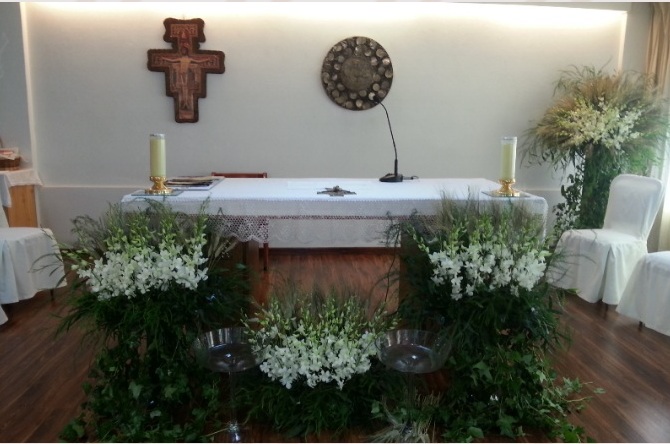With the approach of Easter and in preparation for the celebration, Prestige met Reverend Father François Koussaifi, from the Order of the Capuchin Friars Minor at Saint Francis Convent in Mtayleb. In an exclusive interview, the profound and precise historian, combining action, charisma and erudition, sheds light on highly spiritual themes in a simple and understandable way. Interview.

Can you give us an overview of your religious education? I come from a religious family with a solid faith, practising what we believe in. We are very close to the Church, I would say in the Church, with an aunt and a sister who chose to devote their lives to Christ. I felt that I had the vocation since my first communion, that I lived as a very strong moment, and to which the responsible nun had very well prepared us. And since my name was Francis, something attracted me to Franciscan spirituality, also my sister and aunt were Franciscan Sisters of the Cross. I wanted to enter after the first communion, but I was asked to wait and study to be sure of my vocation. So, when I was 13 years old, I entered seraphic school in Batroun, I did three years of complementary studies, the Novitiate, then I continued my High school studies at Notre-Dame des Anges school, Badaro. Three years of philosophical and theological studies followed at Holy Spirit Kaslik University, with a pastoral year in Deir el Zor and Mesopotamia. During the war of liberation, and following a proposal by the Father General of Capuchins Flavio Carraro, who was visiting Lebanon on the occasion of the election chapter, I continued the first cycle in Milan. In 1993, ordained priest at Notre-Dame des Anges, I served for two years as curate and teacher at Notre-Dame school and Saint-Joseph Batroun. In 1995, I travelled to Italy but this time to Rome, to specialize in Liturgy and Sacred Music. My studies finished, I served ten years in Dubai, and three others at the Church of Our Lady of the Rosary in Qatar. After that, I was appointed parish priest of St. Francis in Hamra and St. Louis Cathedral, Bab Idriss.
What are your impressions from the decade when you stayed in Dubai? I was appointed to Dubai, but in fact, I served in all the Northern Emirates, Dubai, Sharjah, Ras el Khayma, Oum el Kiwan, Fujairah and Ajman. The mission was immense and the faithful were thirsty for the word of God, this gave me the enthusiasm to work sometimes without interruption, day and night. What was beautiful during my service there, with Bishop Bernard Gremoli, we built several churches: the Saint-François d’Assise church in Jabal Ali, that of Saint-Antoine de Padoue in Ras el Khayma (with a great miracle, which no one knows), and the Church of Our Lady of Perpetual Help in Fujairah. This also, and certainly speaking, was the hand of God who worked, and the Holy Spirit guided the work with the intercession of the patron saints.
The first trip of Pope Francis to the Emirates last February carried a message. What was his message, in your opinion? The message that Pope Francis gave to the Emirates was very clear, the title he chose for his visit and which is taken from a prayer of St. Francis of Assisi: «Lord, make me an instrument of your peace». The visit followed an invitation to participate in the Congress of Interreligious Dialogue. The pope was invited because in one of his speeches he separated between terrorism and Islam, at a time when most officials and speeches were confusing Islam as religion and terrorism. In addition, this visit coincided with the 8th centenary commemorating the meeting between St. Francis of Assisi and Sultan Kamel, of which we have so many positive testimonies, St. Francis being considered a pioneer of peace.

What meaning do you give to the Lent period before Easter? Lent is related to Quadragesima, which means forty. So the meanings that I give are in relation to the number 40. It reminds us above all of the 40 days of fasting that Christ spent in the desert. It is a journey that we make with Christ in preparation for the great mystery of his passion, his crucifixion, his death and his resurrection. This is a great mystery, which leads us to prepare for it with a great fast. There are also the 40 years spent by Jewish people in the desert, guided by Moses, to reach the promised land. They certainly experienced difficulties as hunger, thirst, etc., but there is the experience of intimacy with God that wishes to live the whole community of believers. The orientations of the religious authorities speak of three practices that go together: fasting, prayer and charity. I will add two more, namely silence and patience. These activities help us to better prepare ourselves for the celebration of Easter.
The month of March includes three celebrations revolving around the family. St. Joseph on the 19th, Mother’s Day on the 21st and the feast of the Annunciation, on March 25th. All three are loaded with symbols. Do you want to talk to us about it? Every month has its festive occasion, but those of March take on a particular aspect. Let’s not forget that Mother’s Day comes on the day of the equinox, which marks the passage from winter to spring. It falls between the feast of Saint Joseph and that of the Annunciation. The mystery of all mysteries, or even the feast of all feasts, is connected to this event. With the Annunciation, which falls nine months before Christmas, it is joy and hope that enter the world, it is the manifestation of the love of God to all humanity, it is the mystery that was hidden and manifested to the whole world. The Virgin who becomes Mother by the action of the Holy Spirit, who is given as an example for all mothers, and with her chaste husband Saint Joseph, as an example for all families.
Tell us briefly the story of St. Francis Convent in Mtayleb … We bought this convent in 1980. It was a Protestant school, which we transformed into a seraphic school and house of formation. At that time and during the war, our three parishes in Beirut were in danger. This is why we searched for a convent away from the city and at the same time close to schools and universities. At that time, the area was uninhabited and sparsely populated, but our parishioners in Beirut began, gradually, to buy land and build, and the area turned into a city. And as the church became quite busy, we started pastoral activities, such as the Franciscan Third Orders and the Sacred Heart Family, the choir and catechesis, alongside other Franciscan formation activities.

On March 25th 2019, Father François held a conference entitled «Sequela Christi, follow Jesus in the footsteps of Mary».
You organize many parish activities, spiritual retreats, sessions and even an Italian course … These parish activities are prepared according to the needs of the faithful. In addition to the Masses in three languages, Arabic, French and English, we organize three annual retreats, one before Christmas, one before Easter, during Lent, and a third in the month of Mary. We also launched a religious formation centre, during which I gave a course on the sacraments, with a Franciscan orientation.
On March 21, you celebrated the Ambassadors Mass in Saint-Louis Cathedral in downtown. Can you give us an idea of this celebration? The Saint-Louis Cathedral played an important role in the history of Lebanon, especially under the French mandate. It had become almost a religious political centre, welcoming at Mass the French, the generals, the leaders and the French-speakers. Since French was the language of diplomacy, they began to celebrate a mass for the ambassadors, and we perpetuate the tradition. We celebrate Mass when circumstances permit. This year, the Ambassadors Mass was organized by the Latin League.
The Capuchins have been living in Lebanon for a long time. Give us an idea of their history to be followed later … The Capuchins arrived in Lebanon in 1626. But do not confuse with the Friars Minor, who arrived there well before that date. The Capuchins who are still Friars Minor came with Emir Fakhreddine who invited them to Lebanon during his visit to Italy. They settled in Sidon then in Beirut and Abey. Interview Conducted by Mireille Bouabjian








